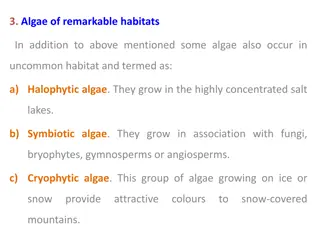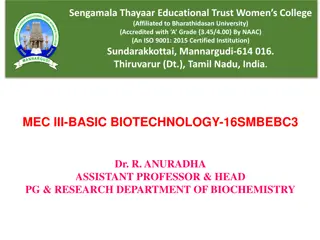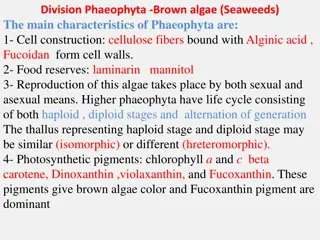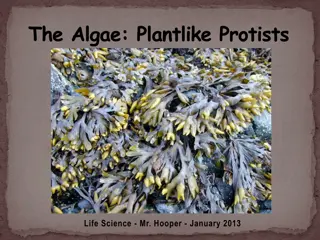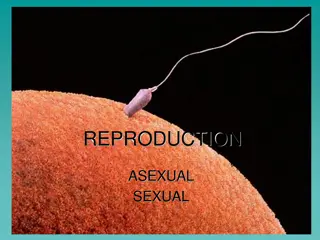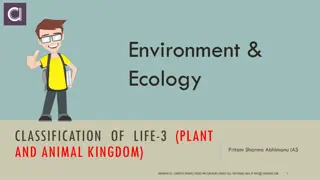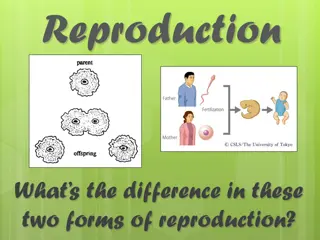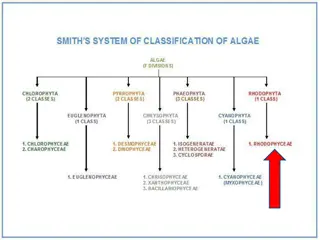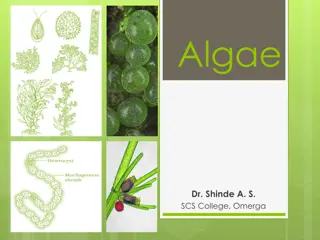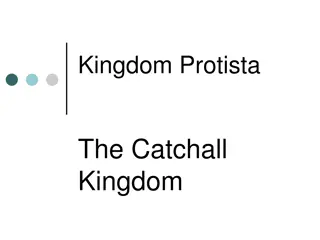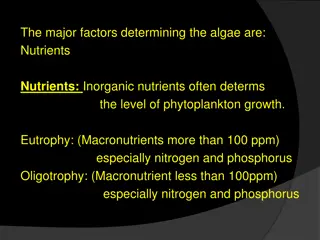Understanding Algae: Classification, Habitat, and Reproduction
Algae are chlorophyllous thallophytes that thrive in aquatic environments, producing their own food and oxygen through photosynthesis. They are categorized based on habitat as aquatic, terrestrial, aerophytes, cryophytes, and thermophytes. The three main classifications of algae are Chlorophyceae (green algae), Phaeophyceae (brown algae), and Rhodophyceae (red algae), each with distinct characteristics. Chlamydomonas, a unicellular motile algae, is commonly found in freshwater habitats and displays both asexual and sexual reproduction. Explore the structure, habitat, and reproduction of these fascinating organisms in more detail.
Download Presentation

Please find below an Image/Link to download the presentation.
The content on the website is provided AS IS for your information and personal use only. It may not be sold, licensed, or shared on other websites without obtaining consent from the author. Download presentation by click this link. If you encounter any issues during the download, it is possible that the publisher has removed the file from their server.
E N D
Presentation Transcript
Algae Algae are the chlorophyllus thallophytes that can manufacture their own food and they produce oxygen during photosynthesis. So they are called as autotrophic thallophytes. The term thallus is used for plant body that is not differentiated into root, stem and leaves. Lacks vascular system. The study of algae is known as phycology.
Habit and habitat The algae re predominantly aquaticand are found both in fresh and salt-water habitats. According to the habitat the algae can be classifiedas: Aquatic algae Terrestrial Aerophytes Cryophytes Thermophytes
Algae Classification There is three main Algae classification: Chlorophyceae These are called green algae, due to the presence of pigments chlorophyll a and b. Examples are Chlamydomonas, Spirogyra, and Chara Phaeophyceae Also called as brown algae, they are predominantly marine. They have chlorophyll a, c, carotenoids and xanthophyll pigments. Examples are Dictyota, Laminaria, and Sargassum Rhodophyceae They are the red algae because of the presence of the red pigment, r-phycoerythrin. Examples are Porphyra, Gracilaria, and Gelidium.
Unicellular motile Chlamydomonas Occurance It is fresh water free swiming alga. It is frequenlty found in standing water, ponds, ditches, pools, rain water and in damp soil. Structure of Chlamydomonas: Chlamydomonas is unicellular, motile green algae. The thallus is represented by a single cell. The shape of thallus can be oval, spherical, oblong, ellipsoidal or pyriform. The pyriform or pear shaped thalli are common, they have narrow anterior end and a broad posterior end
The structure of thallus can be divided into following parts: Cell Wall Cytoplasm Flagella Neuro-motor Apparatus Chloroplast Stigma or Eyespot
Chlamydomonas reproduces both asexually and sexually Asexual reproduction occurs by zoospores, aplanospores, hypnospores, or a palmella stage Sexual reproduction is through isogamy, anisogamy or oogamy
Economic Importance 1. Food: A number of green algae are used as food, e.g., Ulva, Caulerpa, Enteromorpha. Chlorella can yield food rich in lipids, proteins, vitamins and minerals. 2. Antibiotics: They can be extracted from Chlorella and Caulerpa. 3. Parasites: Cephaleuros virescens causes red rust of tea and reduces yield of tea. It also reduces the yield of coffee, pepper, citrus, etc. 4. Sewage Oxidation: Sewage oxidation ponds contain a number of green algae, e.g., Chlamydomonas, Chlorella, Scenedesmus.
https://www.toppr.com/guides/biology/plant-kingdom/algae/ https://www.biologydiscussion.com/algae/life-cycle-algae/chlamydomonas- position-occurrence-and-structure-with-diagrams/21052 https://www.google.com/search?q=structure+of+chlamydomonas&rlz=1C1CHBD_ enPK817PK817&source=lnms&tbm=isch&sa=X&ved=2ahUKEwjpw5zG0OvrAhWUi FwKHRfMB0EQ_AUoAXoECA4QAw&biw=1366&bih=657#imgrc=Q3MO_bgas2pH_ M https://www.biologydiscussion.com/algae/life-cycle-of-chlamydomonas-with- diagram/53699 https://www.biologydiscussion.com/algae/green-algae-characters-and-economic- importance-with- diagram/52153#:~:text=A%20number%20of%20green%20algae,%2C%20proteins% 2C%20vitamins%20and%20minerals.


